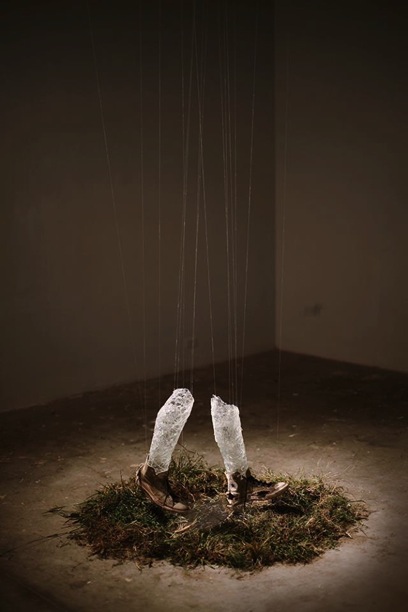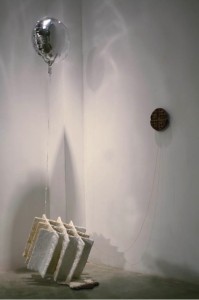Caroline Zemp
Guest Columnist
VCUarts, as many students are aware, is voted one of the top public art schools in the country. Within that realm, the top sculpture department in the country is located here as well. Those in this department use a unique process of creative thought, and to create physical representations of abstract thoughts. Originally from Long Island, New York, with his later life spent in Richmond, sculpture student Maxwell Runko’s style is diverse and contemplative in nature. Mixed with intricacies of his personal life, he creates a body of work that is sentimental to him, and relatable to viewers. He describes to me in this interview his background as a source of strong inspiration, his methods, and some direction towards his future work.

Ink Magazine (IM): So let’s start at the beginning, and kinda go from there. Tell me a little about your upbringing, and when you first started finding interest in art.
Maxwell Runko (MR): Well I was born on Long Island, I was raised there with my older brother, and my twin brother Sam. We moved to Virginia when I was twelve, and we’ve been here ever since… And… when did I first start making art? Well honestly, really as early as I can remember. I always had a knack for it… well not really a “knack” for it. I’ve just always been doing it. My mom was really into crafts, so I crafted things a lot. And I was obsessed with this show called Papi Drew It, and I’d sit there and just draw with this old man for hours. When it got cancelled, I made my dad draw things and then I’d try to duplicate them. I didn’t really take any art classes until 10th grade, or really started to “observe” art.
IM: It seems like a lot of your personal and family experiences influenced your work. Can you kind of elaborate on that, as being a source of inspiration for you?
MR: Yeah, really my immediate family… my brother, my mom and dad… they’re all eternally inspiring to me, but also my grandparents, especially my grandmother and her photography work. Her parents owned a funeral home during the depression so they didn’t really feel it. Then she met my grandfather, moved to Hampton Bays, and they lived on a farm, and she suddenly had to do all this domesticated things that she’d document. And that duality, that contrast is something that interests and inspires me. Even in the natural duality of having a twin brother goes into my work significantly.
IM: So duality has become definitely acted as an inspiration that feeds a theme in your work, then. But you’d say that your family drives your work more than a particular artist does?
MR: Yeah, I guess I’m just not really “inspired” by other artists. I’m driven by them… to like, do something better than they did. I’m inspired in the way that their accomplishments make me want to accomplish more in my own work.

IM: I understand, there’s a lot of confidence in that. So, in regards to other themes that you’re interested right now, what is becoming part of your upcoming work?
MR: Mm, right now something that really intriguing me are souvenirs, and the anthropology and sociology side of actually collecting souvenirs. Its kind of mind blowing, you don’t even realize it’s a science. Materials and materiality is also something a lot of my work deals with, like how materials interact and their connotations. I have almost a sort of fixation with materials. I’ll hoard them and save them all for things. And I’m interested in relationships. Between myself and a lover, myself and my brother, people’s relationship to the art… I like the idea of having some interaction occur, and making people work for something in my art. You can’t just give it ‘em on a silver platter, you know?
IM: And are there ever tendencies in your work to use any sort of motif or recurring message or images?
MR: Honestly the idea of repeating motifs scares me. I feel like you’re stuck. But aside from that, I feel like we as humans go through and do so much that you can’t, or I can’t narrow it all down to one little thing. I don’t let any piece I do lean on another, each one is a step forward. The only dialogue they share is self- improvement in my work. It’s usually just a manifestation of my process.
IM: So you’d say your work not only speaks about your idea behind the project, but also shows the manifestation of the way you work on it then.
MR: Yeah, with a lot of my work, at a certain point during the process I just allow it to become it’s own thing. I can’t control these materials, so it’s like you know you have to surrender yourself to the materials and the way they will direct the final product.
![“wa[oil]ter”, 2013 – Mirrors, steel rods, Mod Podge, food coloring, pine. Glass orb holding oil and water, lit by two purple LED’s.](https://inkmagazinevcu.com/wp-content/uploads/2014/02/maxwell3-300x200.jpg)
MR: In my sculpture right now, I’d like to work on making a series of objects with my twin Sam, We’re gonna focus on making them depict the similarities and differences we have to the viewers. I also want to take a series of images of souvenirs given to me by my grandparents, and then change them completely into another set of objects, colors and materials and then photograph those into a series of their own.
IM: What do you want people to think or feel when they see your work? Is there ever something you’d want people to see in it that might inspire them to create as well?
MR: I guess I’d want my work to be able to do the talking for me. That’s kinda why I like art… I mean I like speaking, but I like it more when my work can speak for itself. Like, the other day a girl came up to me that I had an AFO class with, and told me, “Hey, I just wanted you to know that shoe piece you did, it was one of my favorite pieces you’ve done, and I really loved it.” And its just things like that… I know the work is affecting people. To know they’re grateful for my work, and I am for theirs. That’s all I can ask for at this point.
Art work by Maxwell Runko
(Documentation and Installation help from Nicholas Scarpinato and Andi Francis)

![maxwell3 “wa[oil]ter”, 2013 – Mirrors, steel rods, Mod Podge, food coloring, pine. Glass orb holding oil and water, lit by two purple LED’s.](https://inkmagazinevcu.com/wp-content/uploads/elementor/thumbs/maxwell3-ln6q4ceoir88m384exoyvh4ffdhiz5dqvgk0nr1w9y.jpg)